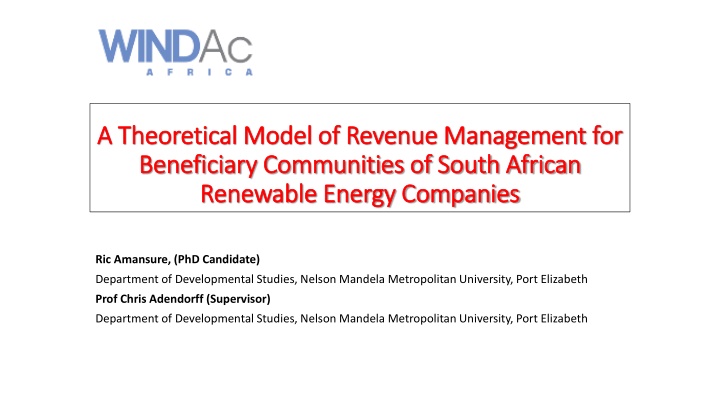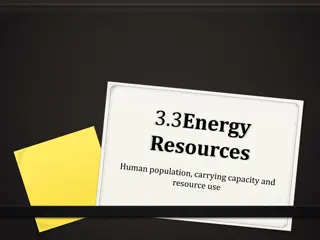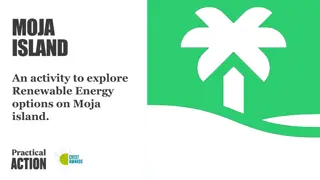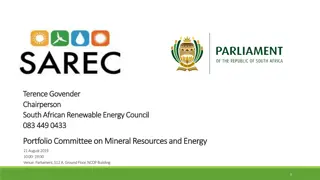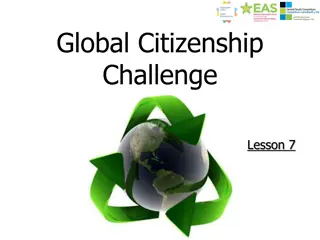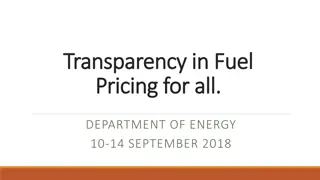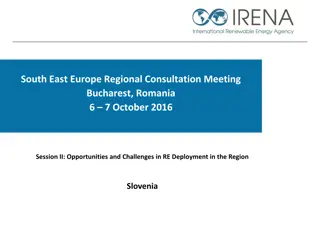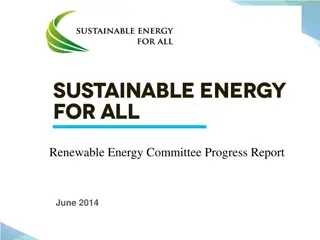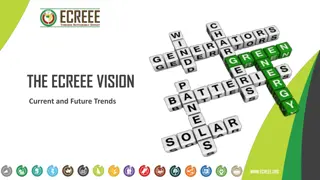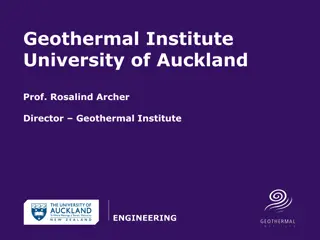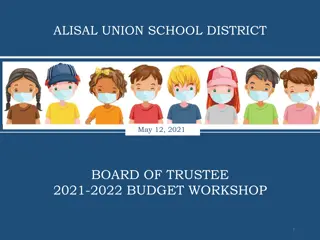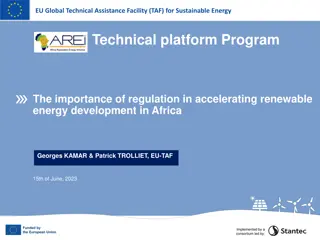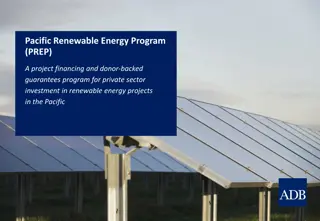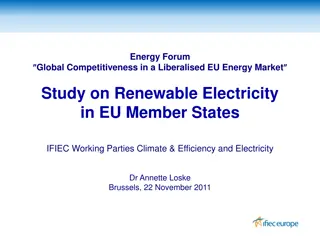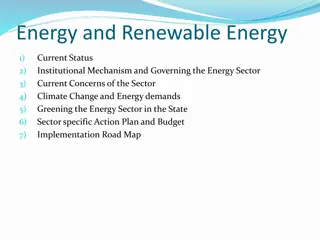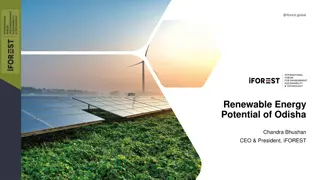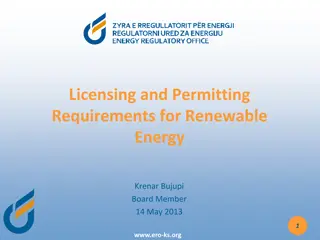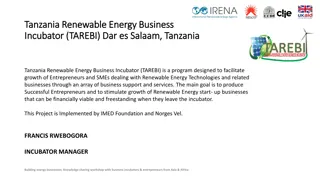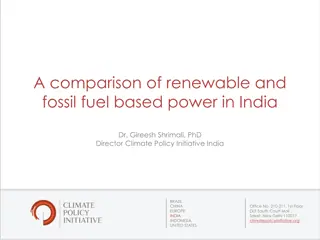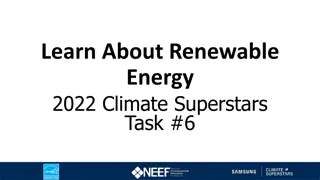Revenue Management Challenges in South African Renewable Energy Sector
The renewable energy sector in South Africa faces challenges in effectively managing revenue to benefit communities. This study aims to analyze existing global guidelines, best practices, and factors influencing revenue management for beneficiary communities in the country. Through a theoretical model, the research seeks to propose solutions for sustainable revenue management in the sector.
Download Presentation

Please find below an Image/Link to download the presentation.
The content on the website is provided AS IS for your information and personal use only. It may not be sold, licensed, or shared on other websites without obtaining consent from the author.If you encounter any issues during the download, it is possible that the publisher has removed the file from their server.
You are allowed to download the files provided on this website for personal or commercial use, subject to the condition that they are used lawfully. All files are the property of their respective owners.
The content on the website is provided AS IS for your information and personal use only. It may not be sold, licensed, or shared on other websites without obtaining consent from the author.
E N D
Presentation Transcript
A Theoretical Model of Revenue Management for A Theoretical Model of Revenue Management for Beneficiary Communities of South African Beneficiary Communities of South African Renewable Energy Companies Renewable Energy Companies Ric Amansure, (PhD Candidate) Department of Developmental Studies, Nelson Mandela Metropolitan University, Port Elizabeth Prof Chris Adendorff (Supervisor) Department of Developmental Studies, Nelson Mandela Metropolitan University, Port Elizabeth
Introduction Introduction The renewable energy sector is one of the fastest growing new industries in the Republic of South Africa (RSA). The Bloomberg New Energy Finance Climate Scope report recently ranked the RSA third globally behind China and Brazil and first among African countries for clean energy investment (Glickman, 2014). However, one of the main benefits to be derived from the industry, that of socio-economic and enterprise development, is not achieving successful revenue management to beneficiary communities in the renewable energy sector in the RSA. governance and long term planning are causing significant harm to already vulnerable communities and threaten to negatively affect the industry s ability to fulfil its obligation to alleviate, transform and ultimately eradicate poverty in some of the poorest communities in the RSA. Challenges such as good
Table 1: Primary Research Objectives PRO1 To analyse the existing global guidelines governing revenue management theories; PRO2 To analyse existing best practises employed by global professionals in the Socio- economic and Enterprise Development consultancies. PRO3 To evaluate the synergies between existing guidelines and procedure related to revenue management to beneficiary communities modelling in the RSA. PRO4 To identify the factors (variables) that will promote management, sustainability and success of revenue management to beneficiary communities in the RSA. PRO5 To develop a conceptual model, propose appropriate hypotheses, and construct a path diagram of relationships between the independent variables and the dependent variable. Source: Researchers own construction
Table 2: Secondary Research Objectives SRO1 To construct a theoretical model that would describe the relationships between the variables SRO2 To develop a measuring instrument that will empirically test the relationships as described in the conceptual mode SRO3 To empirically test the conceptual model and suggested hypotheses by sourcing primary data from renewable industry experts and community development practitioners nationally and internationally, and by statistically analysing the sourced data. SRO4 To discuss the results and interpretation of the research and making appropriate meaningful recommendations based on the outcomes of the statistical analysis. Source: Researchers own construction
Figure 1: The Proposed Theoretical Figure 1: The Proposed Theoretical Model Model
The Research Methodology The Research Methodology In order to test and develop the theoretical model, a positivistic research paradigm was applied to this research study. Snowball sampling was applied to this research as it is appropriate when the members of a special population are difficult to locate (Babbie and Mouton, 2001). A self-administered questionnaire is common to a positivistic research paradigm (Collis & Hussey 2003) and is accordingly one was developed to source the primary data. Adjustments were made to the measuring instrument after it was revealed by the preliminary evaluation and structured questionnaires. The return of 219 fully completed questionnaires, which were used for the statistical analysis of the data, indicated the achievement of the fourth secondary objective. The 7-point Likert-type interval scale was used and respondents were requested to indicate the extent of their agreement or disagreement with regard to each statement, which ranged from 1 (strongly disagree) to 7 (strongly agree). The questionnaires were collated online through an Excel based spread sheet and thereafter downloaded by the researcher for analysis. This data was empirically analysed by means of Structural Equation Modelling (SEM) for the assessment of the hypotheses H1 H21. The proposed theoretical model (Figure 1) illustrates how the independent variables is expected to interrelate with the intervening variable (Good governance) and how the intervening variable is expected to interrelate with the dependent variable Perceived success of revenue management to beneficiary communities.
Demographics Demographics TOTAL RESPONDENTS RESPONDENTS IN RENEWABLE ENERGY RESPONDENTS IN COMMUNITY DEVELOPMENT (Incl. the Extraction Industry) 103 RESPONDENTS IN BOTH COMMUNITY DEVELOPMENT AND RENEWABLE ENERGY 219 116 52 100% 53% 47% 24% NATIONAL RESPONDENTS 171 78% INTERNATIONAL RESPONDENTS 48 22%
Results of the Study and Discussion Results of the Study and Discussion Based on the ratio of sample size to number of indicators recommended, the sample size (219 respondents) of the present study was too small to test the model in its entirety. Hair et al. (2006) suggests that simpler models can be tested with smaller samples. Consequently, a decision to split the original model of factors influencing the perceived success of revenue management into three sub-models was made and to subject each one to SEM individually, namely, Sub-model A (Multi-sector participation), Sub-model B (Transformational change) and Sub-model C (Sustainable initiatives). Each sub-model was individually factor analysed by means of Statistical Product and Service Solutions 23 (SPSS 23) and therefore separate path diagrams were set. All items with loadings <0.4 were deleted.
Concluding remarks Concluding remarks Multi-sector participation: Multi-sector refers to the involvement of government, the private sector and civil society. Participation refers to the leveraging of knowledge and skills; the accessing of expertise, the forming of partnerships and the accessing of resources. The spirit of Ubuntu must be deliberately and actively embraced and put into practise, I am because of others . It must be noted that financial management and good governance are important components of the sub- model and should be treated as such. Multi sector participants should include the following: Private Sector IPPs, Service Providers, Consultants, etc. Local government Integrated Development Plan Provincial government Provincial Strategic Plan National government National Development Plan Community based organisations NPOs, Community forums, etc. Academic institutions Universities, Technical colleges, etc.
Concluding remarks continued Concluding remarks continued Transformational change: Change without transformation is simply window-dressing. Transformation is about changing the way people view themselves self-potential; how people view others around them collective potential and how people view the world around them (including the natural environment) sustainable potential. Transformation involves education, social interaction, social cohesion, infrastructural improvement and sharing. This includes activities such as: Addressing human development needs as a priority Baseline knowledge of, and insight into, the educational and infrastructural needs of the beneficiary communities (including engagement with the community at grassroots level). Scenario forecasting possible futures. The appointment of internal and external service providers. The formation of possible PPPs or collaboration with other IPPs. The management of finances and financial transactions. The monitoring, evaluation and reporting of all activities. The inclusion of policies and procedures in all management processes.
Concluding remarks continued Concluding remarks continued Sustainable initiatives: Sustainability is about ensuring that the community projects that are started will continue to deliver good results way into the future and certainly beyond the life-span of the renewal energy facility for generations to come. Revenue management must be a forward-thinking approach to community development. This includes activities such as: Baseline knowledge and insight of the needs, assets and opportunities in the beneficiary communities (asset mapping and needs analysis and the local governments Integrated Development Plans). Scenario forecasting The appointment of support service providers to offer support and ensure sustainability. The promoting of collaborative and co-operative relationships with other stakeholders, especially local government and neighbouring IPPs. The long-term planning and management of revenue expenditure. A determined and deliberate move towards community-driven development. Greater input and motivation from government (IPP Office), in monitoring, evaluation and reporting of all projects, including the implementation of long term or legacy projects. Pro-active encouragement from government on practical revenue management systems to beneficiary communities that promote sustainability. The inclusion of good governance structures, policies and procedures in all management processes.
Short Learning Programmes (SLPs) Short Learning Programmes (SLPs) As a result of the empirical evidence of the research a number of SLPs have been developed and will be offered at the Cape Peninsular University of Technology (CPUT). These courses are directed at: Courses will cover inter alia: SED Project identification, Due Diligence (Desktop and Field), Preparation of Fact Sheets, Complaints Management, Monitoring and Evaluation, Monthly and quarterly reporting, Annual SED and ED Plans, Risk management, Public Private Partnerships.
Thank you Thank you
